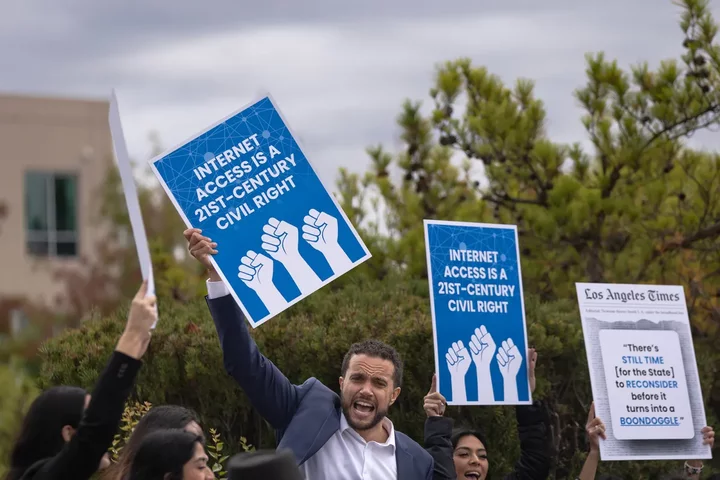Patrick Messac, director of Oakland Undivided, leads a rally to raise awareness about statewide multi-billion dollar broadband projects outside the Covered California headquarters in Sacramento on Oct. 25, 2023. Photo by Rahul Lal for CalMatters
Time is running out to apply for an affordable internet subsidy. The Federal Communications Commission predicts the Affordable Connectivity Program, which gives people $30 to $75 a month for high-speed internet and a one-time $100 credit for a computer or tablet, will run out of money in April.
Barring Congressional action in the next few days, your last chance to apply for the program is Wednesday at 8:59 pm.
If Congress fails to allocate additional funding, nearly 23 million people nationwide and 2.9 million Californians, nearly one in seven residents, will lose affordable high-speed internet funding. In Los Angeles alone nearly 800,000 people currently receive the high-speed internet subsidy intended to narrow the digital divide.
An end to the federal program would also spell the end of a California pilot program to see whether state broadband funding will get more people connected to high-speed internet.
Here are some of the details if you are interested in applying: Those who apply for the federal program this week and are accepted get three months of coverage, after which the program is slated to end. You can check eligibility on this website, and apply online, over the phone, or mail an application. People in assistance programs such as reduced school lunch credits; the Women, Infant, and Children supplemental nutrition program; or college Pell Grants automatically qualify. Only those living on qualifying tribal lands can receive the $75 per month. You’ll need a paycheck stub or tax return to verify income and present proof of identity like a drivers license or a passport from any country.
First instituted as part of the Infrastructure Investment and Jobs Act in 2021, the Affordable Connectivity Program replaces the Emergency Broadband Benefit program, which was created in response to the COVID-19 pandemic to deliver internet coverage to low income households.
For millions of Californians, the barrier to internet access is not infrastructure — the wires are there — but affordability.
Rep. Norma Torres, a Democrat from Ontario, joined in introducing a bill in Congress last month to extend the program with $7 billion — saying high-speed internet is essential for education, health care, and work.
“If funding runs out for this essential program, we risk letting millions of Americans — in both blue and red states — fall back into digital darkness,” Torres said in a statement.
Also at risk in California: the pilot program that allows service providers to bundle California LifeLine (a state program offering discounted landline and cell phone services), a federal LifeLine program and the Affordable Connectivity Program, making life easier and cheaper for consumers.
More concerning, says attorney Ashley Salas of the consumer advocacy group The Utility Reform Network, is that AT&T, the largest provider of LifeLine services in the state, wants to stop providing that service.
If the utilities commission approves AT&T’s pending proposal, the company would no longer be designated as a carrier of last resort designation nor obliged to provide services like LifeLine to low-income residents.The first in a series of hearings throughout the state to gather public comment about AT&T about how ending that designation can affect people begins Tuesday in Clovis, California. Two remote online meetings for all California residents to share their opinion will be held March 19 at 2 pm and 6 pm.
###
CalMatters.org is a nonprofit, nonpartisan media venture explaining California policies and politics.

CLICK TO MANAGE